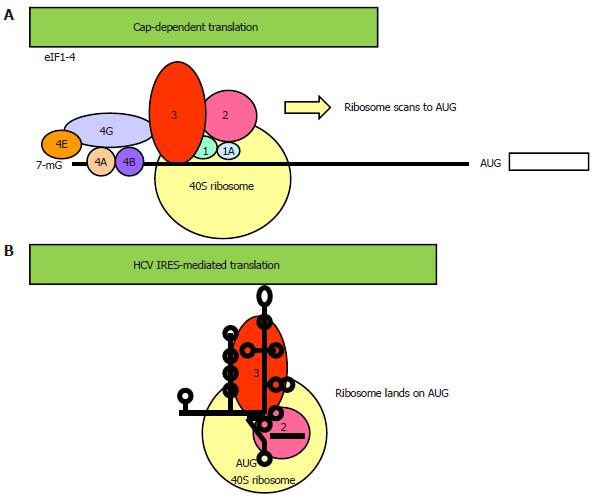Copyright
©2014 Baishideng Publishing Group Co.
World J Gastroenterol. Mar 21, 2014; 20(11): 2785-2800
Published online Mar 21, 2014. doi: 10.3748/wjg.v20.i11.2785
Published online Mar 21, 2014. doi: 10.3748/wjg.v20.i11.2785
Figure 2 Two different modes of translational initiation.
A: Cap-dependent translation. Initiation of translation of most cellular genes requires a 7-methyl guanosine cap-structure at its 5’ end and a full set of canonical eukaryotic translation factors (eIFs) for ribosome binding and scanning to the AUG start codon[29]. The cap-binding complex eIF4F consists of the cap-binding eIF4E, the scaffold eIF4G and the helicase eIF4A. eIF4B promotes the RNA unwinding activity of eIF4A. Recruitment of the 40S ribosomal subunit-eIF3-eIF2 pre-initiation complex to the 5’ end of the mRNA is via protein-protein interaction between eIF4G and eIF3. The ribosomal complex, primed by eIF1/1A, then scans a short distance (50-100 nucleotides) to (usually) the nearest AUG triplet to initiate translation; B: Internal ribosome entry site (IRES)-mediated translation. The viral IRES element spans a considerably longer 5’ untranslated region (UTR) (180-450 nucleotides) that folds into a higher order structure and is interspersed with multiple AUG triplets[37]. The requirement for canonical eIFs varies greatly amongst IRESs, ranging from the dependence of the entire set of eIFs in the picornavirus hepatitis A virus IRES to none of them in the cricket paralysis virus IRES. The hepatitis C virus (HCV) IRES has the second simplest requirement, only needing eIF2 and eIF3. In reminiscent of the prokaryotic ribosomal binding of the Shine-Dalgarno sequence, the HCV IRES can directly recruit the 40S ribosome which lands on the authentic AUG initiator codon[35,63,65]. In some other IRESs, the ribosome lands on an upstream AUG and then scans or shunts to the initiator AUG[37]. An important feature about IRES-mediated translation is that its activity is regulated by IRES trans-acting factors[43].
- Citation: Chan SW. Establishment of chronic hepatitis C virus infection: Translational evasion of oxidative defence. World J Gastroenterol 2014; 20(11): 2785-2800
- URL: https://www.wjgnet.com/1007-9327/full/v20/i11/2785.htm
- DOI: https://dx.doi.org/10.3748/wjg.v20.i11.2785









